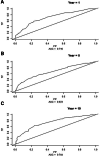Long-Term Risk of Arterial Thrombosis After Intracerebral Hemorrhage: MUCH-Italy
- PMID: 38299371
- PMCID: PMC10896192
- DOI: 10.1161/STROKEAHA.123.044626
Long-Term Risk of Arterial Thrombosis After Intracerebral Hemorrhage: MUCH-Italy
Abstract
Background: The identification of patients surviving an acute intracerebral hemorrhage who are at a long-term risk of arterial thrombosis is a poorly defined, crucial issue for clinicians.
Methods: In the setting of the MUCH-Italy (Multicenter Study on Cerebral Haemorrhage in Italy) prospective observational cohort, we enrolled and followed up consecutive 30-day intracerebral hemorrhage survivors to assess the long-term incidence of arterial thrombotic events, to assess the impact of clinical and radiological variables on the risk of these events, and to develop a tool for estimating such a risk at the individual level. Primary end point was a composite of ischemic stroke, myocardial infarction, or other arterial thrombotic events. A point-scoring system was generated by the β-coefficients of the variables independently associated with the long-term risk of arterial thrombosis, and the predictive MUCH score was calculated as the sum of the weighted scores.
Results: Overall, 1729 patients (median follow-up time, 43 months [25th to 75th percentile, 69.0]) qualified for inclusion. Arterial thrombotic events occurred in 169 (9.7%) patients. Male sex, diabetes, hypercholesterolemia, atrial fibrillation, and personal history of coronary artery disease were associated with increased long-term risk of arterial thrombosis, whereas the use of statins and antithrombotic medications after the acute intracerebral hemorrhage was associated with a reduced risk. The area under the receiver operating characteristic curve of the MUCH score predictive validity was 0.716 (95% CI, 0.56-0.81) for the 0- to 1-year score, 0.672 (95% CI, 0.58-0.73) for the 0- to 5-year score, and 0.744 (95% CI, 0.65-0.81) for the 0- to 10-year score. C statistic for the prediction of events that occur from 0 to 10 years was 0.69 (95% CI, 0.64-0.74).
Conclusions: Intracerebral hemorrhage survivors are at high long-term risk of arterial thrombosis. The MUCH score may serve as a simple tool for risk estimation.
Keywords: area under curve; atrial fibrillation; cerebral hemorrhage; coronary artery disease; myocardial infarction.
Conflict of interest statement
Figures



References
-
- Greenberg SM, Ziai WC, Cordonnier C, Dar D, Francis B, Goldstein JN, Hemphill JC, 3rd, Johnson R, Keigher KM, Mack WJ, et al. ; American Heart Association/American Stroke Association. 2022 guideline for the management of patients with spontaneous intracerebral haemorrhage: a guideline from the American Heart Association/American Stroke Association. Stroke. 2022;53:e282–e361. doi: 10.1161/STR.0000000000000407 - PubMed
-
- Pezzini A, Grassi M, Paciaroni M, Zini A, Silvestrelli G, Iacoviello L, Di Castelnuovo A, Del Zotto E, Caso V, Nichelli PF, et al. Multicentre Study on Cerebral Haemorrhage in Italy (MUCH-Italy) Investigators. Obesity and the risk of intracerebral haemorrhage: the multicenter study on cerebral haemorrhage in Italy. Stroke. 2013;44:1584–1589. doi: 10.1161/STROKEAHA.111.000069 - PubMed
-
- Wada R, Aviv RI, Fox AJ, Sahlas DJ, Gladstone DJ, Tomlinson G, Symons SP. CT angiography “spot sign” predicts hematoma expansion in acute intracerebral haemorrhage. Stroke. 2007;38:1257–1262. doi: 10.1161/01.STR.0000259633.59404.f3 - PubMed
Publication types
MeSH terms
LinkOut - more resources
Full Text Sources
Medical

